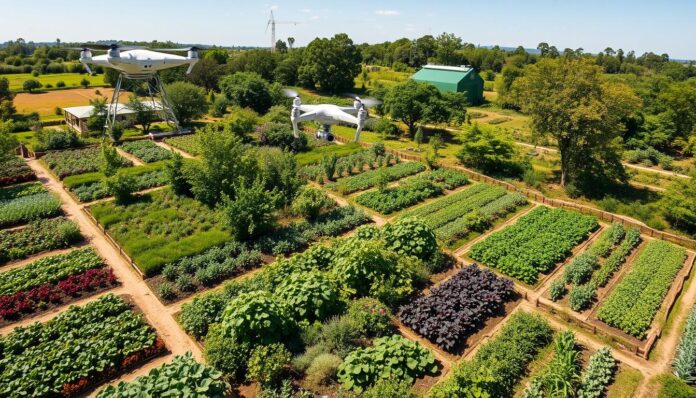Imagine knowing about crop health before any problems show up. Permaculture remote sensing has changed sustainable farming by giving us deep insights into ecosystems.
Now, farmers and designers can see how landscapes work together with great detail. New tools like satellite images and drones are changing how we watch over farms.
With these advanced systems, permaculture experts can follow environmental changes as they happen. This helps them use resources better and make ecosystems stronger. Moving from old farming ways to using data is a big step in growing food in a green way.
Key Takeaways
- Remote sensing technologies provide unprecedented landscape insights
- Geospatial analysis enables precise ecosystem management
- Advanced monitoring supports sustainable agricultural practices
- Drone and satellite technologies enhance crop health tracking
- Data-driven approaches improve resource efficiency
Understanding Permaculture Monitoring Systems
Permaculture monitoring is a smart way to farm that uses new tech and knows a lot about nature. It helps farmers use aerial images and maps to improve their farming.
These systems let farmers check how well their farms are doing. They look at how resources are used and how the farm affects the environment. They use many tools to give farmers a full view of their farm.
Definition of Permaculture Monitoring
Permaculture monitoring is about watching, measuring, and studying farms to make them better. It uses a few main ways:
- Remote sensing techniques
- Precision farming technologies
- Data-driven ecological assessment
“Monitoring is not just about collecting data, but understanding the complex interactions within agricultural ecosystems.” – Ecological Design Expert
Importance of Monitoring in Permaculture
Using aerial images and maps helps farmers see how their crops are doing and how the farm works. These methods help with:
- Targeted resource management
- Early detection of potential issues
- Enhanced sustainable practices
| Monitoring Aspect | Key Benefits |
|---|---|
| Soil Health | Precise nutrient tracking |
| Crop Performance | Real-time growth assessment |
| Water Management | Efficient irrigation strategies |
By using new monitoring tools, permaculture farmers can make farms better. They become more productive and work well with nature.
Key Components of Monitoring Systems
Permaculture monitoring systems are a big step forward in sustainable farming. They use advanced sensors and devices to make monitoring land and crops more precise and green.
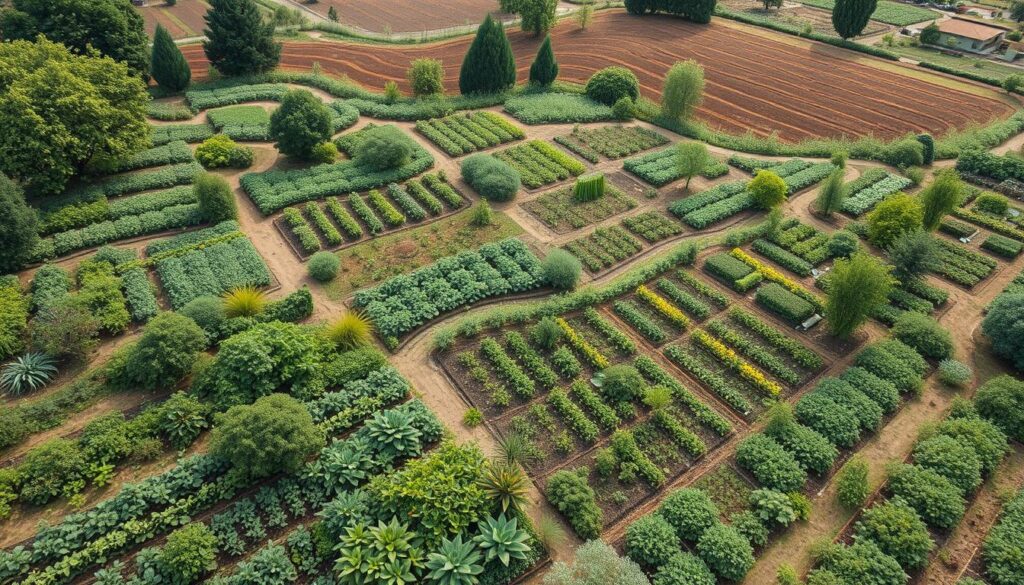
At the heart of good crop monitoring are cutting-edge technologies. They gather vital environmental data. Since the early 1990s, precision agriculture has grown a lot, thanks to yield mapping.
Essential Sensors and Devices
Modern permaculture systems use many smart sensors to track the environment:
- GPS-enabled location trackers
- Soil moisture sensors
- Temperature and humidity monitors
- Wireless network receivers
Data Collection Methods
New ways to collect data have changed land use monitoring. Wireless Sensor Networks (WSNs) give farmers real-time data for better crop management.
The integration of information and control technologies aims to enhance production efficiency while minimizing environmental impacts.
Some key ways to collect data include:
- Remote sensing via satellite imagery
- Unmanned aerial vehicle (UAV) surveys
- Ground-based sensor networks
- Cloud-based data storage and analysis
These green practices help farmers use resources better. Sensor tech can also cut down water waste in farming.
How Permaculture Monitoring Systems Function
Permaculture monitoring systems are at the forefront of environmental conservation. They use advanced technology like geospatial analysis and precision farming. This changes how we manage and understand agricultural ecosystems.
These systems have key parts that help track data in real-time and assess the environment fully:
- Advanced sensor networks for continuous environmental monitoring
- Integrated software platforms for data collection and analysis
- 3D modeling technologies for spatial visualization
Real-Time Data Tracking
Real-time data tracking lets permaculture experts get instant environmental metrics. They use sophisticated microclimatic monitoring techniques. This way, farmers can understand their land with great detail.
| Monitoring Parameter | Technology Used | Data Collection Frequency |
|---|---|---|
| Soil Moisture | Wireless Sensors | Continuous |
| Temperature | IoT Thermometers | Real-Time |
| Plant Health | Spectral Imaging | Hourly |
Integration with Software Platforms
Modern permaculture monitoring systems link up different data sources through advanced software. These platforms turn raw environmental data into useful insights. This helps farmers make precise decisions in their farming strategies.
Technology is transforming permaculture from an art to a data-driven science of sustainable agriculture.
Benefits of Implementing Monitoring Systems
Sustainable agriculture needs new ways to manage crops. Modern monitoring systems are key for farmers to improve their farming and protect the environment.
Advanced monitoring systems bring big changes to farming. Crop monitoring technologies change how farmers see and manage their farms.
Enhanced Crop Health Monitoring
Modern systems give farmers deep insights into crop health. The main benefits are:
- Real-time tracking of plant health
- Early signs of disease or stress
- Accurate tracking of crop growth
Using these systems, farmers can see big improvements. Data-driven monitoring can lead to:
| Metric | Improvement |
|---|---|
| Yield Increases | 15-20% |
| Water Usage Reduction | 30% |
| Input Cost Reduction | 25% |
Sustainable Resource Management
Monitoring systems are vital for environmental conservation. They give detailed info on soil, moisture, and ecosystems. This helps farmers adopt sustainable farming.
Advanced monitoring turns farming into a sustainable, data-driven practice.
By using sensors and satellite images, farmers can make better choices. This protects natural resources and keeps farms productive.
Types of Monitoring Systems in Permaculture
Permaculture monitoring systems have changed how farmers and land managers track the environment. They use advanced technologies to get deep insights into land use and precision farming.
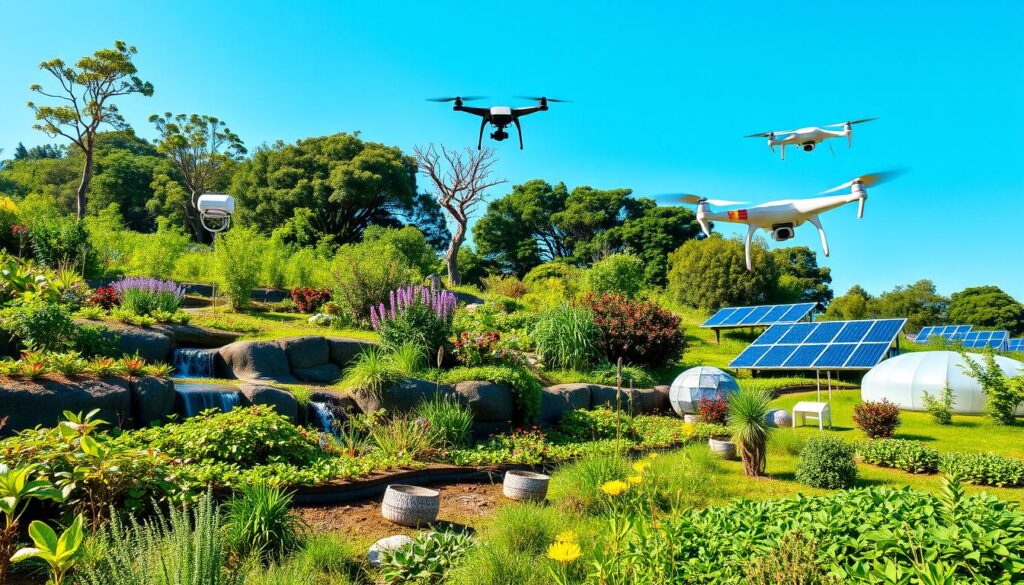
Effective permaculture remote sensing technologies help with detailed environmental assessments. They use different monitoring methods.
Soil Monitoring Systems
Soil health is key to successful permaculture. Modern systems offer many ways to understand soil conditions:
- Digital soil sensors measure nutrient levels
- Wireless pH tracking devices
- Moisture content analyzers
- Organic matter composition detectors
“Soil is the fundamental infrastructure of any agricultural ecosystem.” – Permaculture Design Principle
Now, precision farming uses advanced sensors. These sensors give real-time data on soil, helping farmers make quick decisions.
Weather and Climate Monitoring
Tracking the climate is vital in permaculture. Advanced systems collect detailed environmental data:
| Monitoring Type | Key Metrics | Technology Used |
|---|---|---|
| Temperature Tracking | Ambient and ground temperature | Wireless IoT sensors |
| Precipitation Analysis | Rainfall volume and intensity | Satellite and ground-based radar |
| Wind Pattern Assessment | Direction and speed | Anemometer networks |
By using these advanced systems, permaculture experts can create more resilient farms. These farms adapt well to environmental changes.
Technologies Driving Monitoring Systems
The world of permaculture is changing fast thanks to new tech. As farming gets harder, new tech is key for green farming.
The global IoT market for green farming is growing fast. It was worth about USD 11.4 billion in 2021. By 2026, it’s expected to hit USD 18.1 billion, growing 9.8% each year.
IoT and Sensor Technologies
New sensor tech is changing how we look at permaculture. These systems track the environment closely. They give us deep insights into how crops grow and ecosystems work.
- Real-time environmental monitoring
- Detailed vegetation mapping capabilities
- Advanced aerial imagery analysis
Software Innovations
New software is changing how we collect and use data. It uses smart algorithms to turn aerial images and sensor data into useful info for farmers.
“Technology is the bridge between traditional farming and sustainable agricultural practices.”
| Technology | Key Benefit |
|---|---|
| IoT Sensors | Real-time crop monitoring |
| Geospatial Analysis Tools | Precise environmental mapping |
| Drone Imagery | Comprehensive vegetation assessment |
By 2025, the agri-tech market worldwide is expected to hit $27.5 billion. This shows how big the role of tech is in green farming.
Case Studies of Effective Monitoring Systems
Permaculture monitoring systems have changed sustainable agriculture a lot. Advanced monitoring technologies are now helping farmers and conservationists track their work better.
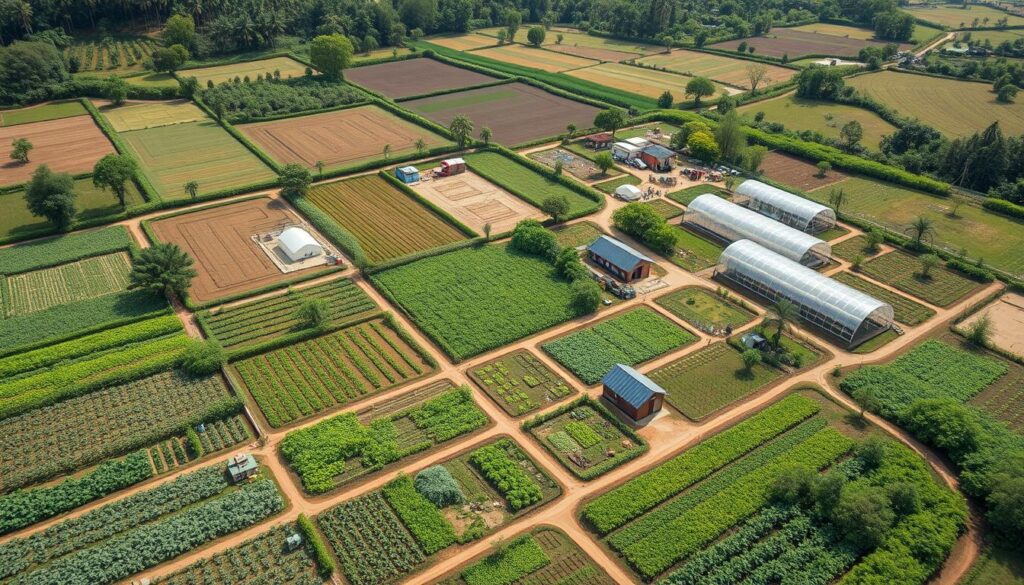
Real-world examples show how eco-friendly practices in agriculture can make a big difference. The Australian wool industry is a great example of using remote sensing:
- Livestock management optimization
- Enhanced decision-making processes
- Precise environmental resource tracking
Successful Implementation Strategies
Several strategies have worked well in using permaculture monitoring systems. Data-driven approaches are key in saving the environment. New technologies help us understand ecosystems better.
Monitoring systems represent the intersection of technology and ecological stewardship, providing unprecedented insights into sustainable agricultural practices.
Lessons from Real-World Applications
Researchers have learned a lot from using these systems:
- Collecting data continuously helps manage better
- Tracking in real-time saves resources
- Integrated systems give a full view of ecosystems
Statistics show why these systems are important. About 25% of greenhouse gas emissions come from farming. This highlights the need for advanced monitoring to fight climate change.
Challenges in Monitoring Permaculture
Monitoring permaculture is complex due to the need for precision farming and crop monitoring. These systems are intricate and require advanced methods to overcome technical and financial hurdles.
Permaculture monitoring faces big challenges that affect its success and use:
Technical Limitations in Precision Farming
- Complex sensor calibration needs
- Accuracy issues in remote areas
- Compatibility problems with technology
- Signal issues in varied landscapes
Financial Barriers to Advanced Monitoring
There are big economic hurdles to setting up full crop monitoring systems. Small permaculture projects face:
- High costs for starting technology
- Expenses for ongoing maintenance
- Difficulty in getting advanced tools
- Need for training on complex systems
“The biggest challenge in permaculture monitoring is making technology accessible.” – Sustainable Agriculture Research Group
Remote sensing technologies might help solve these problems. They could lower costs for field checks. Using three types of mapping—NDVI, elevation, and K-Gamma—can help overcome some monitoring challenges.
Knowing these challenges helps permaculture experts create better monitoring plans. This ensures sustainable land use practices keep improving.
Future Trends in Permaculture Monitoring
The world of sustainable farming is changing fast with new tech. Permaculture remote sensing and geospatial analysis are making farming smarter and more adaptable. This is creating better ways to manage ecosystems.
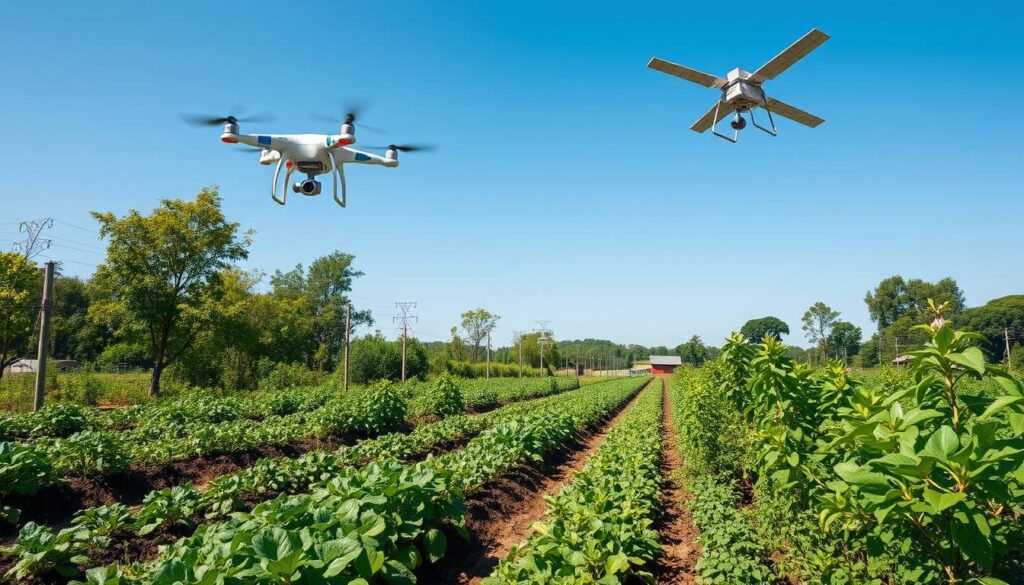
Artificial intelligence is changing farming for the better. It uses advanced algorithms to help farmers predict and manage their land with great accuracy.
Advances in AI and Machine Learning
AI is bringing big changes to permaculture monitoring. These smart systems can:
- Analyze complex environmental data with remarkable accuracy
- Predict potential ecological changes
- Recommend optimal planting strategies
- Detect early signs of pest infestations
The use of computer vision lets us identify species and monitor ecosystems in detail.
Increased Automation
Automation is changing how we analyze land in farming. IoT devices and sensors collect data in real-time. This helps farmers make quick, informed decisions.
“The future of agriculture lies in intelligent, data-driven ecosystem management.”
The global Precision Agriculture Market was worth USD 9.34 Billion in 2022. It’s expected to grow at 10.11% each year. This shows how important these new technologies are.
Best Practices for Using Monitoring Systems
Precision farming uses advanced monitoring systems. These systems change how farmers manage their land. They help farmers watch over their crops better and save the environment.
Keeping your monitoring gear in good shape is key. It helps you get accurate data. This is important for farming in a way that’s good for the planet.
Regular Maintenance Techniques
- Check your sensors every month
- Clean them every three months
- Update your software often
- Check your wireless setup
Data Interpretation Strategies
Understanding your data is important. It turns raw numbers into useful information. Using advanced tech can spot patterns in nature.
| Data Interpretation Method | Key Benefits |
|---|---|
| Statistical Analysis | Shows long-term trends |
| Machine Learning Algorithms | Forecasts changes in nature |
| Visual Data Mapping | Gives a clear view of the area |
“Effective monitoring turns data into ecological knowledge, empowering farmers to make informed decisions.” – Permaculture Research Institute
By following these tips, farmers can improve their farming. They can watch over their crops better. This helps the environment too.
Integrating Monitoring with Permaculture Design
Sustainable agriculture needs smart design that links data collection with nature. Permaculture monitoring is key to understanding and improving land use. It uses advanced technology to do this.
Modern permaculture design uses new monitoring tech to boost eco-friendly farming. It makes farms more adaptable and responsive. This is thanks to smart systems.
Designing for Data Accessibility
Good data access in permaculture needs careful planning. Here are some important steps:
- Use easy-to-use digital dashboards
- Make tools for real-time data
- Develop simple interfaces for sensors
- Set up platforms for all data
*”Data transforms observation into actionable ecological intelligence.”*
Creating Feedback Loops
Feedback loops help improve sustainable farming. AI can look at lots of data, like:
- Weather forecasts
- Soil analysis
- Maps of ecosystems
- Tracking biodiversity
By linking monitoring with design, farmers can boost crop survival by 30%. They also lower ecological risks with predictive analytics.
Monitoring tech makes farming more precise. It changes old farming ways into smart, nature-friendly management.
Educational Resources for Permaculture Monitoring
To improve your skills in permaculture remote sensing, you need good educational resources. Both professionals and hobbyists can find many ways to learn. These paths help deepen your knowledge of sustainable agriculture and how to analyze data using geospatial analysis.
Online Courses and Workshops
Today, you can find online courses focused on permaculture monitoring. These programs teach important skills like:
- Advanced mapping technologies
- GIS software applications
- Remote sensing techniques
- Sustainable agriculture design principles
Community Learning Networks
Being part of professional communities offers great insights into using permaculture monitoring in real life. You can find:
- International permaculture forums
- Specialized geospatial analysis discussion groups
- Online workshops and webinars
- Regional sustainable agriculture networks
“Continuous learning is the cornerstone of innovative permaculture practices” – Sustainable Agriculture Research Institute
A recent survey shows a big interest in permaculture education worldwide. With 23% of survey participants from North America and people from over 51 countries, learning resources are getting more global.
Professionals can use these resources to get better at remote sensing. They can develop smart monitoring plans and help make sustainable agriculture better.
Conclusion: The Future of Permaculture Monitoring Systems
Sustainable agriculture is at a key point where technology meets caring for the earth. AI is changing precision farming by making predictions and analyzing data better. Now, we can watch crops in real time, learning more about our ecosystems.
Permaculture experts can use these advanced systems to protect our environment. They can spot pests and diseases early, keeping our ecosystems healthy. Machine learning helps farmers plan the best crops based on weather and soil, across different farms.
Key Takeaways
Research shows that monitoring systems in permaculture are more than just tools. They are a new way to farm sustainably. By using AI and traditional knowledge, farmers can make their farms stronger and more productive. This approach goes beyond just growing more food, aiming to care for the land and environment.
Call to Action
Farmers and those in agriculture should look into using these new technologies. By adopting these tools, they can farm in a more precise, adaptable, and earth-friendly way. The future of farming is about using the latest tech while respecting nature.

